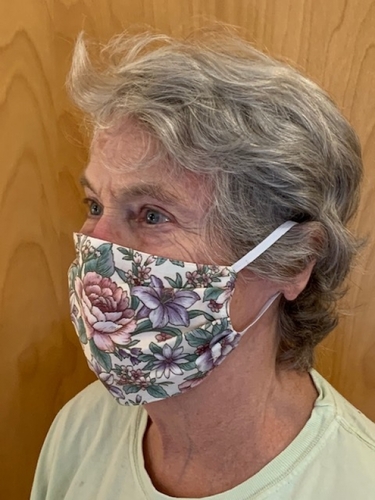TOWNSHEND — With a nationwide shortage of professional-grade protective face masks, it has fallen to volunteers who are handy with a sewing machine to fill the gap.
Across Windham County, and all over the United States, the needle-and-thread brigade has stepped up to help, as state and national health officials have escalated their call to wear the masks in public.
Brattleboro Memorial Hospital has received hundreds of homemade masks from community members. The hospital has produced a flyer with instructions on how to make cloth masks, covers for N95 respirator masks, and isolation gowns.
Christy Foote-Smith, one of several volunteers sewing face masks for Grace Cottage Hospital, said she tries to choose fabric with “colorful and cheery” patterns.
Foote-Smith said she was introduced to the idea of making masks from social media. She said that after reflecting on all the “good care” Grace Cottage staff had provided her and her husband over the years, she wanted to give back.
“I'm so grateful for the wonderful staff and the wonderful care that the staff provide to the community,” Foote-Smith said.
So she called Grace Cottage. Could the hospital use homemade face masks?
Yes, came the answer.
So, out came Foote-Smith's sewing machine.
Inspired to give back
Foote-Smith said she followed a video from Deaconess Hospital in Indiana.
She said she also watched a video where someone added an unused vacuum filter to the mask as an added protective layer. But those vacuum filters can't go through the wash, so she added a layer of light interfacing - a special fabric used to add heft and strength to a garment - as an added filter to make the masks “even more protective.”
The homemade masks are reusable, washable, and able to go through a sterilization process, she said.
She recommended to anyone considering making the masks to follow the instructions to the letter. The first few times she didn't, and after the masks were washed they turned out too tight.
Now retired, Foote-Smith said that when she worked in an operating room years ago, the masks in use had ties, not elastic. With it becoming increasingly difficult to order the elastic that loops around the wearer's ears, she plans to make them with ties.
Another volunteer and quilter, Sonessa “Lee” Miller, of Wardsboro, said she decided to sew masks “because of the need, and it felt like something I could do.”
On a lighter note, she added, “I'm a seamstress by nature, and my husband just bought me a new machine. It's a good excuse to learn this machine.”
Like most quilters, Miller said she's collected loads of fabric over the years, and she is sorting through her library for “funny or humorous” patterns.
She recommends to anyone making the masks to make sure all the layers - three, with interfacing - are “exactly the same size.”
That's an emphasis on “exactly.” In a few of her early masks, Miller said she did not pay close attention to her measurements and had trouble making sure the sewing machine's needle caught all three layers.
She estimates that each mask takes her 30 minutes to make, but she believes that she has been working slowly.
“I'm speeding this up,” Foote-Smith said of her mask production.
Masks contain the sneezes and coughs
Foote-Smith said she had just received a call from the small hospital's senior director, Andrea Seaton, who told Foote-Smith that the hospital needed more masks.
“They are absolutely gorgeous,” Seaton said. “They really cheer everyone up just to see them.”
According to Seaton, the 71-year-old hospital is using the masks for patients and visitors who request them. The hospital's employees who are not on the front line of patient care are also using the homemade masks.
The medical-grade face masks, designed to protect health care workers from viruses like COVID-19, are for the hospital's direct-patient care staff, she said.
“[The homemade masks] are better at keeping sneezes and coughs from getting out rather than keeping them from getting in,” she said.
Seaton said she felt grateful and touched by the outpouring of support that community members are showing by sewing the masks.
The homemade masks also symbolize to the hospital staff how much the community cares, Seaton said.
“We're hoping for the best but preparing for the worst,” Seaton said.
As of March 31, the hospital had three patients test positive for the virus. So far, all have been able to recover at home.
Grace Cottage has instituted a drive-up testing process.
In a recent newsletter, the hospital noted that the costs related to the organization's COVID-19 efforts have exceeded current revenues. The organization also thanked the community for its monetary donations.
The hospital has committed to keeping its staff employed throughout the pandemic.
In the meantime, Foote-Smith said, her goal is to “just get them out there. The need is only going to grow.”
